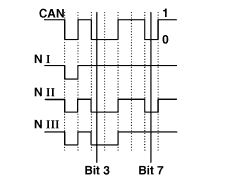
| GF54.00-P-0005-02A | CAN data bus specification | all |  |
| In order to be able to process data in real time, it must be possible to transfer data quickly. This presupposes not only a quick physical data path but also demands a quick CAN data bus division when multiple control units simultaneously want to transfer. To distinguish between the importance of different CAN messages that are being sent over the CAN data bus there exists priorities for the individual messages. The ignition angle, for example is assigned high priority, the slip value medium priority and the outside temperature has a lower priority. |
The priority by which the CAN message is established is through the identifier of the (address) particular CAN message
An identifier which corresponds to a low binary number has a high priority and vice versa. The CAN protocol is based on two logic states: The bits are either "recessive" (logic 1) or "dominant" (logic 0). If a dominant bit is sent by at least one station, recessive bits sent by other stations are overwritten. |
| Example
If several control modules transmit a message at the same time, the conflict of bus access is solved by means of bus arbitration using the appropriate idenitifers. The transmitor checks every bit when the arbitration field is sent whether it is able to be sent or whether another control unit is sending a CAN transmission of higher priority. If a recessive bit transferred by the first sending unit is overwritten by a dominant bit from another sending unit, the first sending unit looses its right to transmit (arbitration) and it becomes a receiver. The first control module (N I) looses the arbitration with bit 3. The third control module (N III) looses the arbitration with bit 7. The second control unit (N II) maintains bus access and can send its CAN massage. |
 | |
| P54.00-1038-01 |
| The other control units then try to send their CAN messages when the CAN data bus is free.The right to send is newly divided according to the priority. |